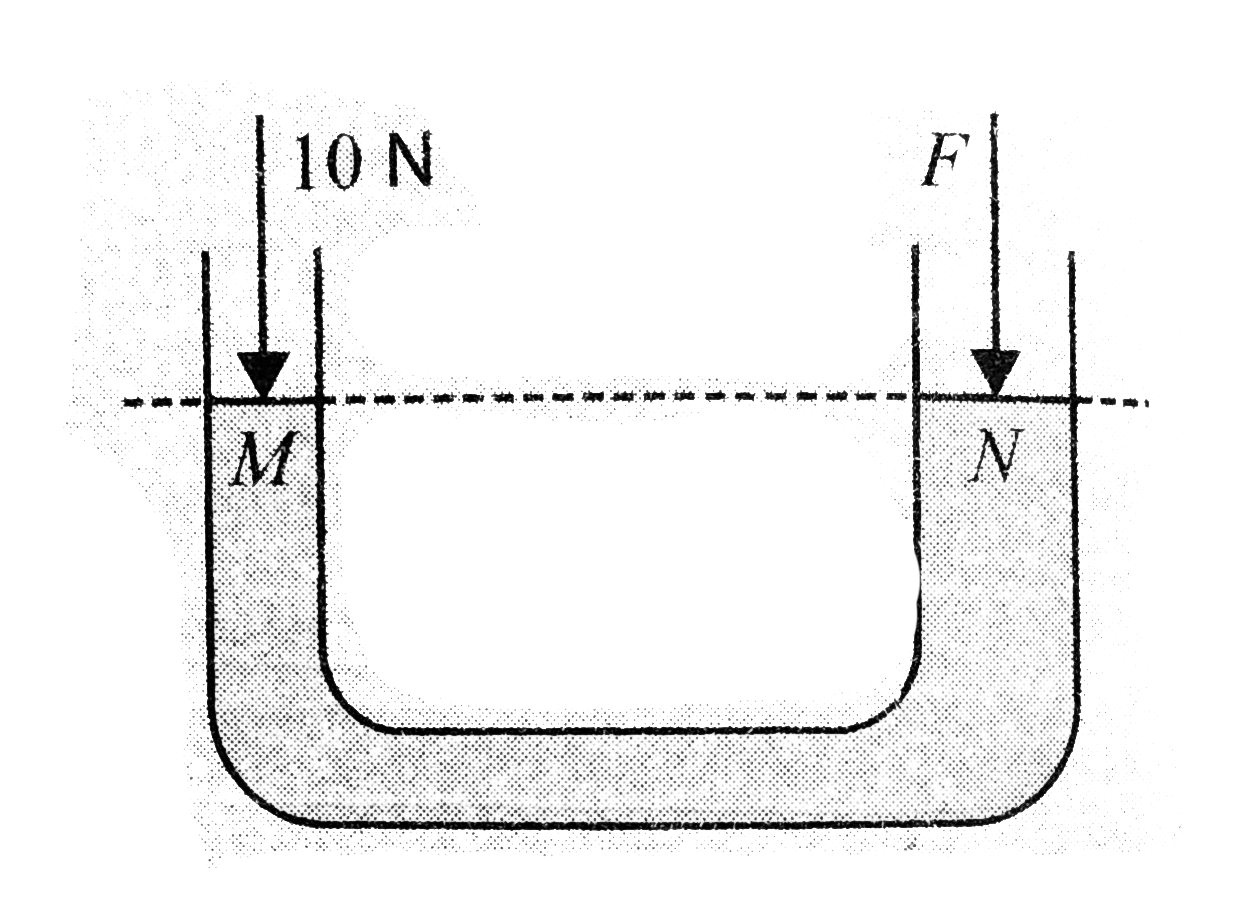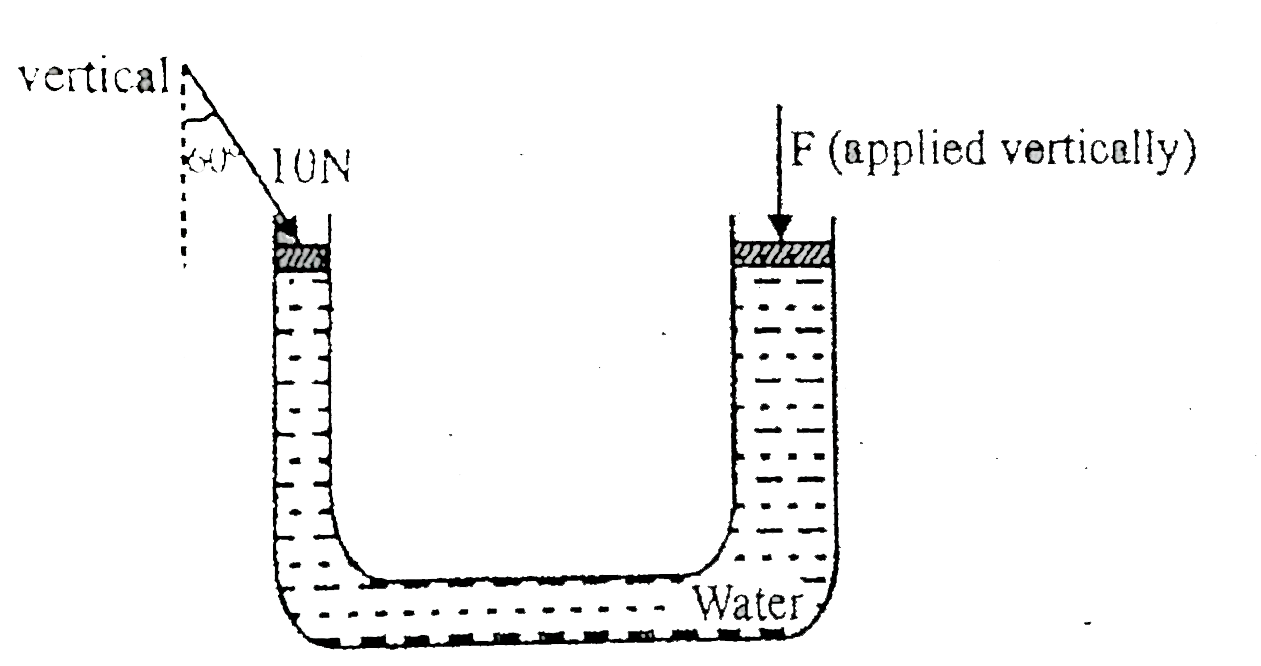The radius of one arm of a hydraulic lift is three times the radius of the other arm. What force should be applied on the narrow arm so as to lift 50 kg at the wider arm?
60 N
54.4 N
26.7 N
30 N
The correct Answer is:B
To solve the problem of determining the force that should be applied on the narrow arm of a hydraulic lift to lift a 50 kg weight on the wider arm, we can follow these steps:
Step 1: Understand the relationship between the radii
Given that the radius of the wider arm (R2) is three times the radius of the narrow arm (R1), we can express this relationship mathematically:
R2=3R1
Step 2: Calculate the force due to the weight
The weight (F2) of the object being lifted can be calculated using the formula:
F2=m⋅g
where:
- m=50kg (mass of the object)
- g=9.8m/s2 (acceleration due to gravity)
Calculating F2:
F2=50kg⋅9.8m/s2=490N
Step 3: Use the hydraulic lift principle
According to the principle of hydraulic lifts, the pressure is the same on both sides:
F1A1=F2A2
where:
- F1 is the force applied on the narrow arm,
- A1 is the area of the narrow arm,
- A2 is the area of the wider arm.
Step 4: Calculate the areas in terms of the radii
The areas can be expressed in terms of the radii:
A1=πR12
A2=πR22=π(3R1)2=9πR12
Step 5: Substitute the areas into the pressure equation
Substituting the areas into the pressure equation gives:
F1πR12=490N9πR12
Step 6: Simplify the equation
The πR12 terms cancel out:
F1=490N9
Step 7: Calculate F1
Now, calculating F1:
F1=4909≈54.44N
Final Answer
The force that should be applied on the narrow arm is approximately:
F1≈54.44N
Given that the radius of the wider arm (R2) is three times the radius of the narrow arm (R1), we can express this relationship mathematically:
R2=3R1
The weight (F2) of the object being lifted can be calculated using the formula:
F2=m⋅g
where:
- m=50kg (mass of the object)
- g=9.8m/s2 (acceleration due to gravity)
F2=50kg⋅9.8m/s2=490N
According to the principle of hydraulic lifts, the pressure is the same on both sides:
F1A1=F2A2
where:
- F1 is the force applied on the narrow arm,
- A1 is the area of the narrow arm,
- A2 is the area of the wider arm.
The areas can be expressed in terms of the radii:
A1=πR12
A2=πR22=π(3R1)2=9πR12
Substituting the areas into the pressure equation gives:
F1πR12=490N9πR12
The πR12 terms cancel out:
F1=490N9
Now, calculating F1:
F1=4909≈54.44N
The force that should be applied on the narrow arm is approximately:
F1≈54.44N
Topper's Solved these Questions
- BOOK - AAKASH INSTITUTE ENGLISHCHAPTER - MECHANICAL PROPERTIES OF FLUIDSEXERCISE - SECTION - B23videos
MECHANICAL PROPERTIES OF FLUIDS
- BOOK - AAKASH INSTITUTE ENGLISHCHAPTER - MECHANICAL PROPERTIES OF FLUIDSEXERCISE - SECTION - C15videos
MECHANICAL PROPERTIES OF FLUIDS
- BOOK - AAKASH INSTITUTE ENGLISHCHAPTER - MECHANICAL PROPERTIES OF FLUIDSEXERCISE - TRY YOURSELF41videos
MECHANICAL PROPERTIES OF FLUIDS
- BOOK - AAKASH INSTITUTE ENGLISHCHAPTER - MAGNETISM AND MATTER EXERCISE - ASSIGNMENT (SECTION D)26videos
MAGNETISM AND MATTER
- BOOK - AAKASH INSTITUTE ENGLISHCHAPTER - MECHANICAL PROPERTIES OF SOLIDSEXERCISE - Assignment(Section-D)14videos
MECHANICAL PROPERTIES OF SOLIDS
Similar Questions
The area of cross section of the two arms of a hydraulilc press are 1 cm^2 and 10 cm^2 respectively figure. A force of 5N is applied on the water in the thinner arm. What force should be applied on the water in the thicker arm so that the water may remain in equilibrium?
 ,View Solution
,View SolutionThe area of cross section of the two arms of a hydraulilc press are 1 cm^2 and 10 cm^2 respectively figure. A force of 5N is applied on the water in the thinner arm. What force should be applied on the water in the thicker arm so that the water may remain in equilibrium?
 ,View Solution
,View SolutionThe area of cross sectioin of the two arms of a hydraulic press is 1cm2 and 20cm2 respectively. A force of 10N is applied on the water in the thinner arm. What force should be applid on the water in the thicker arms so that water may remain in equilibrium?
 View Solution
View SolutionA disc has mass 'M" and radius 'R'. How much tangential force should be applied to the rim of the disc so as to rotate with angular velocity ω in time 't'?
View SolutionA block of mass 2 kg rests on an inclined plane which makes an angle of 30∘ with the horizontal. The coefficient of friction between the block and the surface is √3/2. (i) What force should be applied on the block so that it moves down without any acceleration ? (ii) What force should be applied on the block so that it moves up without any acceleration ? (iii) Calculate the ratio of the powers in the above two cases if the block moves with uniform speed in both the cases.
View SolutionThe area of cross-section of the two vertical arms of a hydraulic press are 1 cm2 and 10cm2 respectively. A force of 10N applied. As shown in the figure, to a tight fitting light piston in the thinner arm balances a force F applied to the corresponding piston in the thicker arm. Assuming that the levels of water in both the arms are the same, we can conclude:-
 View Solution
View SolutionIn a hydraulic lift, used at a service station the radius of the large and small piston are in the ration of 20:1. What weight placed on the small piston will be sufficient to lift a car of mass 1500kg ?
View SolutionA body of mass m is lifted up from the surface of earth to a height three times the radius of the earth R. The change in potential energy of the body is
View SolutionThe average mass that must be lifted by a hydraulic press is 80kg.If the radius of the larger piston is five times that of the smaller piston, what is the minimum force that must be applied?
View SolutionA u tube contains water and methylated spirit separated by mercury. The mercury columns in the two arms are at the same levels with 10 cm of water in one arm and 12.5 cm of spirit on the other arm as shown. If 15 cm of water and spirit each are further poured into the respective arms of the tube. Difference in the level of mercury in the two arms is (Take, relative density of mercury = 13.6, relative density of spirit=0.8)
View Solution

